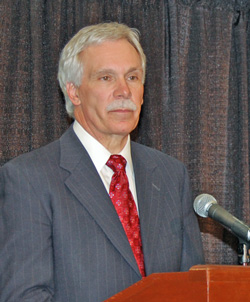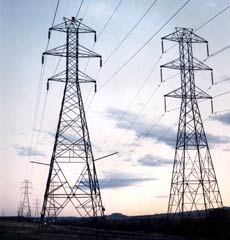Secretary of Agriculture Ed Schafer has only been on the job officially for about a month but he has been busy making the rounds of farm meetings. During his appearance at the 2008 Commodity Classic on Friday, Schafer expressed great optimism for agriculture – record prices, record farm income, record exports and the blending of energy and agriculture.
 During a press conference following his appearance at the general session, Schafer fielded questions from farm media about biofuels and ethanol in particular. Asked if there was any chance that there might be a delay in implementing the new Renewable Fuels Standard because of recent reports claiming that biofuels are bad for the environment, Schafer said no.
During a press conference following his appearance at the general session, Schafer fielded questions from farm media about biofuels and ethanol in particular. Asked if there was any chance that there might be a delay in implementing the new Renewable Fuels Standard because of recent reports claiming that biofuels are bad for the environment, Schafer said no.
“I don’t because no matter what happens it’s not going to have an effect this year,” Schafer said. “We are getting to the point of topping out on ethanol production, not because of production capacity, but because of our ability to deliver it in the current infrastructure.”
“The research dollars are going in to move from ethanol to the cellulosic generation,” Schafer continued. “While we are playing catch up on non-price distorting feedstocks for ethanol, which is going to take some time, we do think we are arriving at the levels this year where we are going to see a leveling off of (commodity) prices.”
Listen to Schafer’s comments here:
[audio:http://www.zimmcomm.biz/commodity-classic/schafer-press-ethanol.mp3]
Domestic Fuel coverage of the 2008 Commodity Classic
is sponsored by: 


 While some car makers might be betting the future for fuels will be a mix of several different sources, one major European carmaker seems to be happy to put all of its eggs in one basket.
While some car makers might be betting the future for fuels will be a mix of several different sources, one major European carmaker seems to be happy to put all of its eggs in one basket. The South Dakota State House and Senate has voted unanimously to approve a bill that would cut state taxes on diesel mixed with biodiesel.
The South Dakota State House and Senate has voted unanimously to approve a bill that would cut state taxes on diesel mixed with biodiesel. Officials with the National Biodiesel Board are telling those who depend on their trucks… and the fuel they put in those trucks… for their living that the quality of biodiesel is getting better.
Officials with the National Biodiesel Board are telling those who depend on their trucks… and the fuel they put in those trucks… for their living that the quality of biodiesel is getting better. You can’t turn a corner at the 2008 Commodity Classic trade show without seeing something about ethanol. A record crowd is attending the Classic this year – more than 4450 people and over 140 media are in Nashville and the corn-fed enthusiasm is driven in a large part by the ethanol buzz.
You can’t turn a corner at the 2008 Commodity Classic trade show without seeing something about ethanol. A record crowd is attending the Classic this year – more than 4450 people and over 140 media are in Nashville and the corn-fed enthusiasm is driven in a large part by the ethanol buzz. Everybody who is anybody in the ethanol industry is here – the
Everybody who is anybody in the ethanol industry is here – the  But its only just begun. Friday will feature Secretary of Agriculture Ed Schafer during the general session followed up by a John Deere Learning Center Session on Starch and Cellulose as Ethanol Feedstocks. And Saturday night everybody will be “Corn Fed” with a concert featuring the lovely and talented Shannon Brown.
But its only just begun. Friday will feature Secretary of Agriculture Ed Schafer during the general session followed up by a John Deere Learning Center Session on Starch and Cellulose as Ethanol Feedstocks. And Saturday night everybody will be “Corn Fed” with a concert featuring the lovely and talented Shannon Brown. The Ethanol Promotion and Information Council is now in the publishing business after announcing the introduction of “Ethanol Retailer” magazine this week. Robert White, Publisher, is pictured (center) during a panel he participated in on E85 during the National Ethanol Conference. I interviewed Robert about the new venture and the panel he was on.
The Ethanol Promotion and Information Council is now in the publishing business after announcing the introduction of “Ethanol Retailer” magazine this week. Robert White, Publisher, is pictured (center) during a panel he participated in on E85 during the National Ethanol Conference. I interviewed Robert about the new venture and the panel he was on. The sudden skyrocketing of wind energy production, especially in areas of the Midwest and rural parts of Texas and California, is outdistancing the the capacity for the nation’s high-voltage lines to get that clean electricity into the nation’s cities.
The sudden skyrocketing of wind energy production, especially in areas of the Midwest and rural parts of Texas and California, is outdistancing the the capacity for the nation’s high-voltage lines to get that clean electricity into the nation’s cities. The U.S House today approved $18 billion in new taxes on the oil companies that will fund incentives for renewable energy.
The U.S House today approved $18 billion in new taxes on the oil companies that will fund incentives for renewable energy. Buses in Central Florida will soon be running on a blend of their own biodiesel… a first in the country for any bus fleet.
Buses in Central Florida will soon be running on a blend of their own biodiesel… a first in the country for any bus fleet. The
The